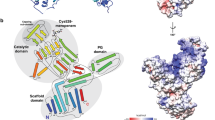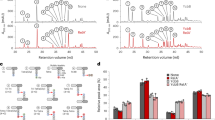Abstract
BACTERIA have been shown to become resistant to β-Lactam antibiotics (penicillin and cephalosporins) by the following methods: decreased permeability1,2, increased production of an enzyme (β-Lactamase) which degrades the antibiotics1, acquisition of a plasmid that produces a β-Lactam3,4, and a decreased affinity of the lethal target for the antibiotic5. β-Lactam antibiotics are thought to kill bacteria by interfering with the terminal stages of cell wall biosynthesis6. The cross-linking of the cell wall by a transpeptidase enzyme has been implicated as the probable target site7,8, although inhibition of a carboxypeptidase9 and stimulation of autolytic activity10 have also been proposed. It has been suggested that penicillin is a transition state analogue of the D-alanyl-D-alanine moiety of the donor molecule in the transpeptidation reaction11and that penicillin binds covalently to the transpeptidase7. Investigations therefore concentrated on enzymes which could fix penicillin in bacterial membranes12,13. Bacteria contain multiple penicillin binding proteins (PBPs) and it is important to identify which one is the lethal target. One approach used in this laboratory has been to purify the individual PBPs and investigate their enzymatic activity, although it was realised that solubilisation might lead to inactivation. In Bacillus megaterium the only PBP shown to possess enzymatic activity was PBP 5 (ref. 14) (the one of lowest molecular weight), and this was the D, D-Ala carboxypeptidase, which is much less sensitive to β-lactams than is growth of the organism15. Despite the lack of enzymatic activity the affinity of the remaining PBPs 1–4 for benzylpenicillin could be measured in whole cells. PBP 1 was the only protein that interacted covalently with benzyl-penicillin at the lowest concentration of the antibiotic that would inhibit growth, and it was therefore proposed to be the lethal target16. An alternative approach is to determine which PBPs become altered as an organism develops resistance to an antibiotic. This method has shown that resistance can be due to a PBP having a decreased affinity for a β-Lactam antibiotic. Using this technique PBP 2 has been identified as the lethal target for mecillinam in Escherichia coli5 and for cloxacillin in Bacillus subtilis17. However, in this report a new mode of resistance is described in which there is a purely quantitative change in the ratio of PBP 1 to PBP 3 as resistance to cloxacillin develops in B. megaterium. Thus, resistance results from a decrease in the level of the lethal target which is compensated by an increase in a less sensitive target.
This is a preview of subscription content, access via your institution
Access options
Subscribe to this journal
Receive 51 print issues and online access
$199.00 per year
only $3.90 per issue
Buy this article
- Purchase on Springer Link
- Instant access to full article PDF
Prices may be subject to local taxes which are calculated during checkout
Similar content being viewed by others
References
Boman, H. G., Nordstrom, K. & Normark, S. Ann. N.Y. Acad. Sci. 235, 569–586 (1974).
Rodriguez, W. & Saz, A. R. Antimicrob. Ag. Chemother. 7, 788–792 (1975).
Richmond, M. H. & Curtis, N. A. C. Ann. N.Y. Acad. Sci. 235, 553–567 (1974).
Rolinson, G. N. Proc. R. Soc. B179, 403–410 (1971).
Spratt, B. G. Nature 274, 713–715 (1978).
Ghuysen, J. M. J. gen. Microbiol. 101, 3–33 (1977).
Tipper, D. J. & Strominger, J. L. Proc. natn. Acad. Sci. U.S.A. 54, 1133–1141 (1965).
Wise, E. M. & Park, J. T. Proc. natn. Acad. Sci. U.S.A. 54, 75–81 (1965).
Hammes, W. P. Eur. J. Biochem. 70, 107–113 (1976).
Tomasz, A. & Waks, S. Proc. natn. Acad. Sci. U.S.A. 72, 4162–4166 (1975).
Lee, B. J. molec. Biol. 61, 463–469 (1971).
Blumberg, P. M. & Strominger, J. L. Proc. natn. Acad. Sci. U.S.A. 69, 3751–3755 (1972); J. biol. Chem. 247, 8107–8113 (1972).
Spratt, B. G. & Pardee, A. B. Nature 254, 516–517 (1975).
Chase, H. A., Shepherd, S. T. & Reynolds, P. E. FEBS Lett. 76, 199–203 (1977).
Reynolds, P. E. & Barnett, H. J. Ann. N. Y. Acad. Sci. 235, 269–282 (1974).
Reynolds, P. E., Shepherd, S. T. & Chase, H. A. Nature 271, 568–570 (1978).
Buchanan, C. E. & Strominger, J. L. Proc. natn. Acad. Sci. U.S.A. 73, 1816–1820 (1976).
Bonner, W. M. & Laskey, R. A. Eur. J. Biochem. 46, 83–88 (1974).
Laskey, R. A. & Mills, A. D. Eur. J. Biochem. 56, 335–341 (1975).
Tamaki, S., Nakajima, S. & Matsuhashi, M. Proc. natn. Acad. Sci. U.S.A. 74, 5472–5476 (1977).
Author information
Authors and Affiliations
Rights and permissions
About this article
Cite this article
GILES, A., REYNOLDS, P. Bacillus megaterium resistance to cloxacillin accompanied by a compensatory change in penicillin binding proteins. Nature 280, 167–168 (1979). https://doi.org/10.1038/280167a0
Received:
Accepted:
Published:
Issue Date:
DOI: https://doi.org/10.1038/280167a0
This article is cited by
Comments
By submitting a comment you agree to abide by our Terms and Community Guidelines. If you find something abusive or that does not comply with our terms or guidelines please flag it as inappropriate.



